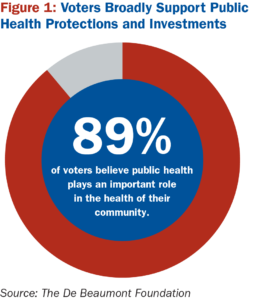The Impact of Chronic Underfunding of America’s Public Health System: Trends, Risks, and Recommendations, 2019
An examination of federal, state, and local public health funding trends and recommended investments and policy actions to prioritize prevention and effectively address 21st century health threats.
Executive Summary
This annual report examines federal, state, and local public health funding, and it recommends investments and policy actions needed to prioritize prevention, effectively address 21st century threats, and ultimately achieve optimal health for all Americans. With chronic underfunding putting lives at risk, the stakes are rising.
The United States has made enormous strides in improving population health and longevity, but significant challenges remain. More than a third of adults, and nearly one in five children, have obesity, costing the nation hundreds of millions in related health care expenses. Tobacco use is still the leading cause of preventable death. Risks from infectious disease, drug-resistant superbugs, and foodborne illness continue to pose a challenge. A rapid rise in deaths from drugs, alcohol, and suicide represent an urgent crisis. Weather-related emergencies are becoming more frequent and intense, as the world begins to feel the effects of climate change. And across most health outcomes, socioeconomic, racial, and ethnic disparities persist.
Tackling these issues requires a strong, well-resourced public health system focused on prevention, preparedness, wellness, and community recovery for all Americans. But chronic underfunding has presented a consistent obstacle. In 2017, public health represented just 2.5 percent — $274 per person — of all health spending in the country.
Such underfunding flouts overwhelming evidence of the life-saving cost-effectiveness of programs that prevent diseases and injuries and prepare for disasters and health emergencies. Public health interventions, such as childhood vaccinations, school-based violence prevention programs, and indoor smoking bans, improve health outcomes and prevent illness and death. Moreover, many such interventions save money; a 2017 systematic review of the return on investment of public health interventions in high-income countries found a median return of 14 to 1.
In an age of widening political polarization, public health programs enjoy broad support. A September 2018 poll of U.S. voters found that 89 percent of respondents believed that public health plays an important role in the health of their community. A majority of voters (57 percent) were willing to pay higher taxes to ensure that everyone has access to basic public heath protections.

Federal Public Health Funding
Federal dollars support a wide range of essential public health programs that aim to improve health, prevent diseases and injuries, and prepare for potential disasters and major health emergencies. Much of this money flows through the U.S. Centers for Disease Control and Prevention (CDC), with additional funds going to other agencies within the U.S. Department of Health and Human Services (HHS), as well as the United States Department of Agriculture (USDA).
CDC Funding Trends
The CDC is the nation’s leading public health agency. Its mission is to protect Americans from disease outbreaks, disasters, and unsafe food and water, and to reduce the incidence of leading causes of Americans’ deaths. To help accomplish its objectives, the CDC supports states, localities, tribes, territories, and community organizations in addressing leading health threats in their communities. Indeed, more than half of its program funding is redistributed to these partners.
The CDC’s budget has not kept pace with the nation’s growing public health needs and emerging threats, particularly the rise in substance misuse and weather-related emergencies. The agency has expanded its substance misuse efforts in the past few years, but more resources are needed to address underlying causes, such as the impact of trauma or the lack of supportive school and community environments. Its funding for effective obesity and community prevention programs is inadequate to sufficiently support every state. Despite rapid growth in the elderly population, funding to support healthy aging at the CDC is minimal. Recent increases to funding for public health emergency preparedness, including for weather-related emergencies, have not made up for resources lost in earlier years, let alone emerging threats. Finally, the CDC also lacks sufficient dedicated funding to adequately support the cross-cutting, foundational capabilities that form the backbone of comprehensive public health systems at the federal, state, and local levels.
Fiscal Year (FY) 2019 program funding for the CDC, as enacted in September 2018, is $7.3 billion. After accounting for interagency transfers and one-time funding, this reflects a $143 million (2 percent) increase over FY2018–or flat funding in inflation-adjusted dollars.
The CDC’s FY2018 budget saw its biggest year-over-year uptick ($1.079 billion, including $480 million in one-time funding for laboratory facilities) over the past decade. A third of these additional dollars — about $350 million — were meant to support the response to the devastating opioid epidemic. Of the CDC’s funds that go to states, support ranged in FY 2018 from $17.09 per person in New Jersey to a high of $63.28 per person in Alaska.
Looking further back, the CDC’s budget fell by 10 percent over the past decade (FY 2010-19), after adjusting for inflation.
Appropriately comparing funding levels in FY 2018 and FY 2019 requires accounting for the transfer of funding for the Strategic National Stockpile from the CDC to the Assistant Secretary for Preparedness and Response in FY 2019, and excluding one-time lab funding in FY 2018. Data were adjusted for inflation using the Bureau of Economic Analysis’s implicit price deflators for gross domestic product.
Read the fullImpact of Chronic Underfunding of America’s Public Health System, Trends, Risks, and Recommendations, 2019 report.